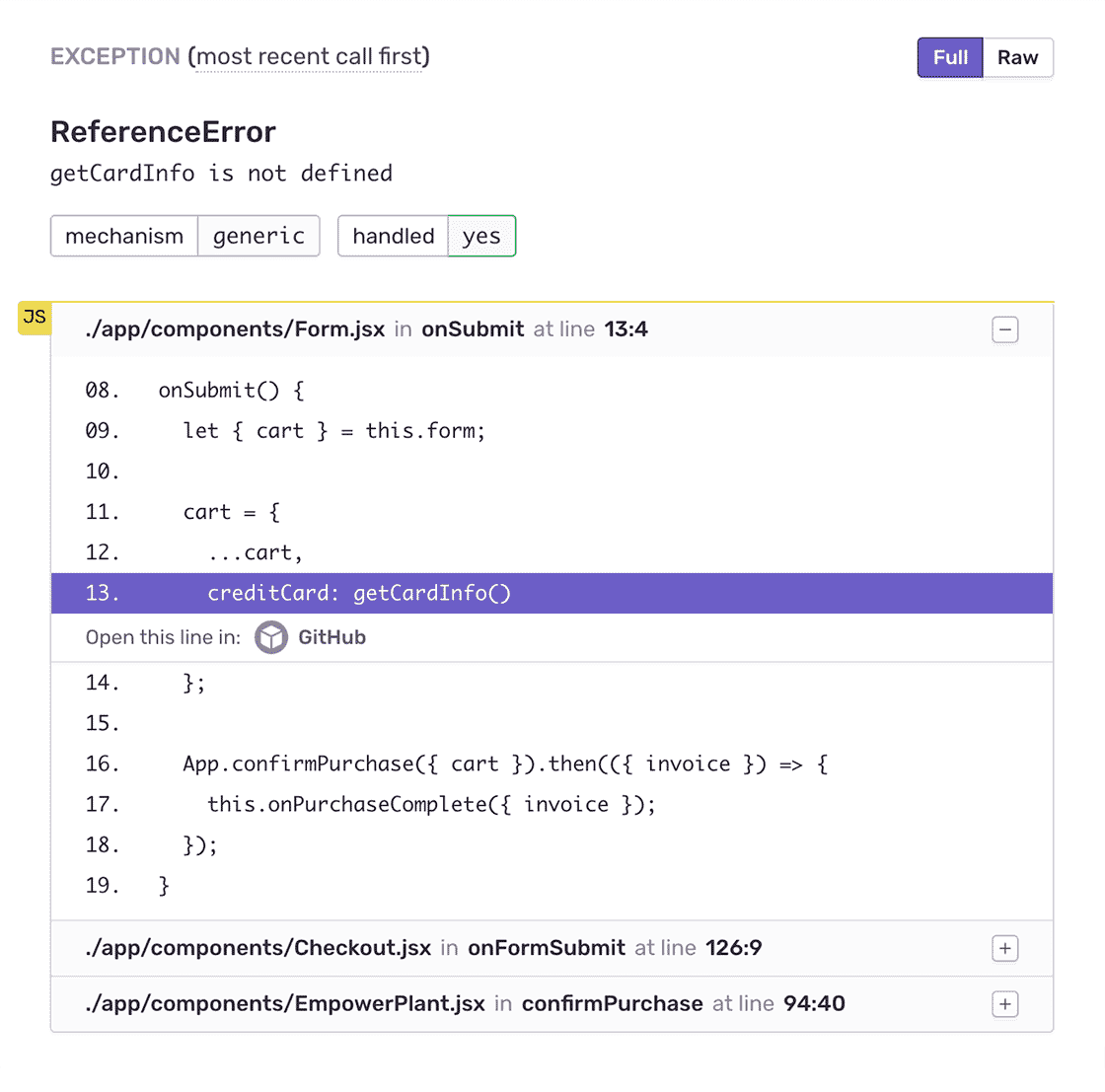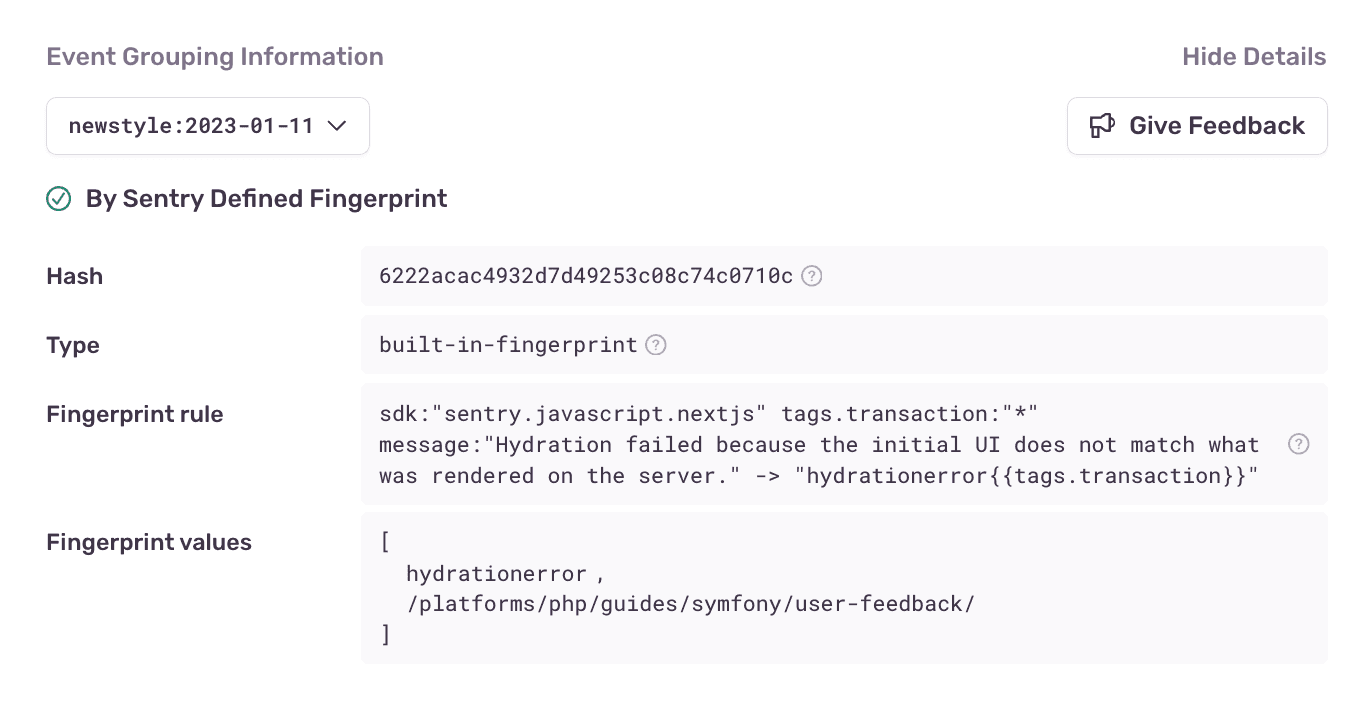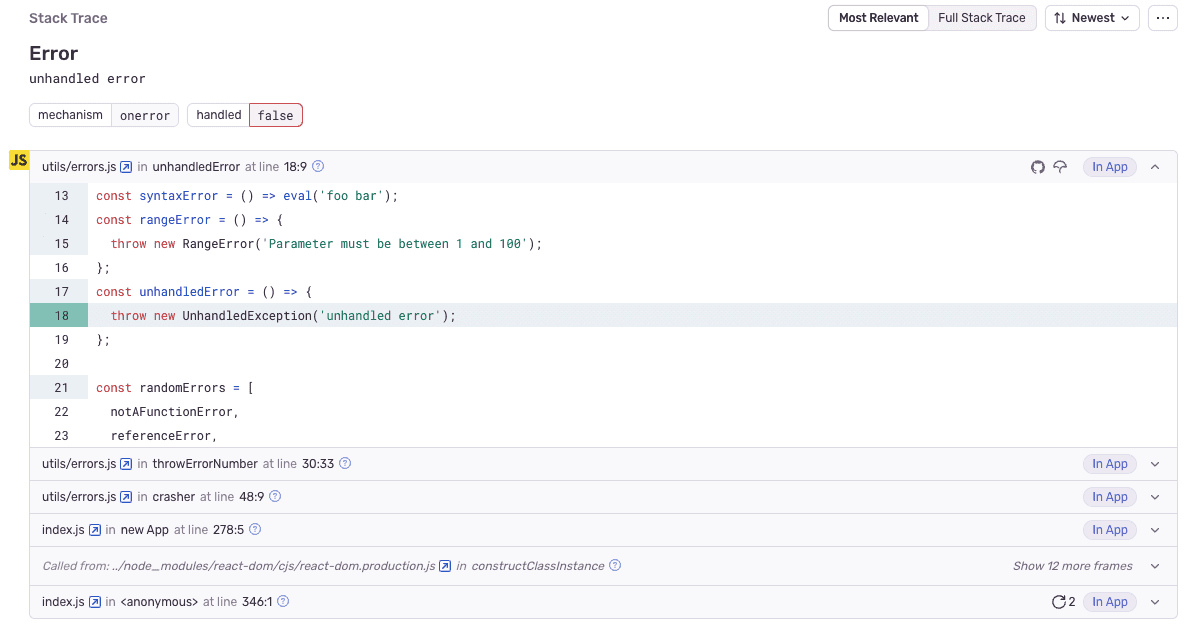Like stack traces,
but more and better
Stack traces, also referred to as a backtrace, are often used to debug or troubleshoot. Sentry enhances stack traces with all the information you wish they had to enhance debuggability.


Issue filters
To reduce noise, Sentry groups related issues by analyzing stack traces, exceptions, and messages, surfacing the most critical issues. Plus, you can update filters to focus on application-specific errors, include framework errors, or show the raw trace for deeper debugging.

Stack locals
For Node, Python, and PHP you can see the exact value of each variable at the time of the crash or error.
Compression got you down?
Sentry can show your source code even if it has been minified, compiled, transpiled, or beguiled.
Sensitive data scrubbing
We automatically scrub things that include personal information, such as credit cards, passwords, or api_keys.
You can also specify custom values to scrub and filter data on the client side before it gets sent to us.
FAQs
A stack trace is the sequence of function calls that led to an error in your code. When an exception occurs, the stack trace allows you to see exactly where the error was thrown and the path the code took to get there. Stack traces are essential for debugging because they provide detailed insight into which part of the application failed, especially in complex, layered systems.
In tools like Sentry, stack traces are enhanced with features like source code visibility, so you can see the actual lines of code that triggered the error without hunting down files manually. Sentry also supports sourcemaps for JavaScript, allowing you to debug minified or transpiled code easily.

Yes, stack traces should absolutely be logged, but they should not be the only thing logged. Stack traces give you immediate feedback on where your application crashed, often giving you insight into why your application crashed. Traditional logs are useful for understanding the broader context around the event, such as user actions or system state leading up to the error.
Sentry leverages stack traces as part of issue details and offers more context by attaching error data, such as breadcrumbs (user behavior leading up to the crash) and traces (interactions among your software systems).
Yes, stack traces can expose sensitive details, especially in production environments, if not handled properly. Stack traces may reveal file paths, function names, or even sensitive data if the application doesn’t sanitize them. To mitigate these risks, you should avoid exposing stack traces to end users and instead log them securely.
Sentry includes security features like automatic scrubbing of sensitive data (e.g., passwords, API keys), and allows developers to customize what information gets logged. This ensures that stack traces are useful for debugging but do not inadvertently expose sensitive information.
We do other cool things too
A peek at your privacy
Here’s a quick look at how Sentry handles your personal information (PII).
×Who we collect PII from
We collect PII about people browsing our website, users of the Sentry service, prospective customers, and people who otherwise interact with us.
What if my PII is included in data sent to Sentry by a Sentry customer (e.g., someone using Sentry to monitor their app)? In this case you have to contact the Sentry customer (e.g., the maker of the app). We do not control the data that is sent to us through the Sentry service for the purposes of application monitoring.
Am I included?PII we may collect about you
- PII provided by you and related to your
- Account, profile, and login
- Requests and inquiries
- Purchases
- PII collected from your device and usage
- PII collected from third parties (e.g., social media)
How we use your PII
- To operate our site and service
- To protect and improve our site and service
- To provide customer care and support
- To communicate with you
- For other purposes (that we inform you of at collection)
Third parties who receive your PII
We may disclose your PII to the following type of recipients:
- Subsidiaries and other affiliates
- Service providers
- Partners (go-to-market, analytics)
- Third-party platforms (when you connect them to our service)
- Governmental authorities (where necessary)
- An actual or potential buyer
We use cookies (but not for advertising)
- We do not use advertising or targeting cookies
- We use necessary cookies to run and improve our site and service
- You can disable cookies but this can impact your use or access to certain parts of our site and service
Know your rights
You may have the following rights related to your PII:
- Access, correct, and update
- Object to or restrict processing
- Port over
- Opt-out of marketing
- Be forgotten by Sentry
- Withdraw your consent
- Complain about us
If you have any questions or concerns about your privacy at Sentry, please email us at compliance@sentry.io.
If you are a California resident, see our Supplemental notice.